【寺島拓篤のイラストリテラシー#2】漫画家・三輪士郎さんと「影付け」に挑戦!
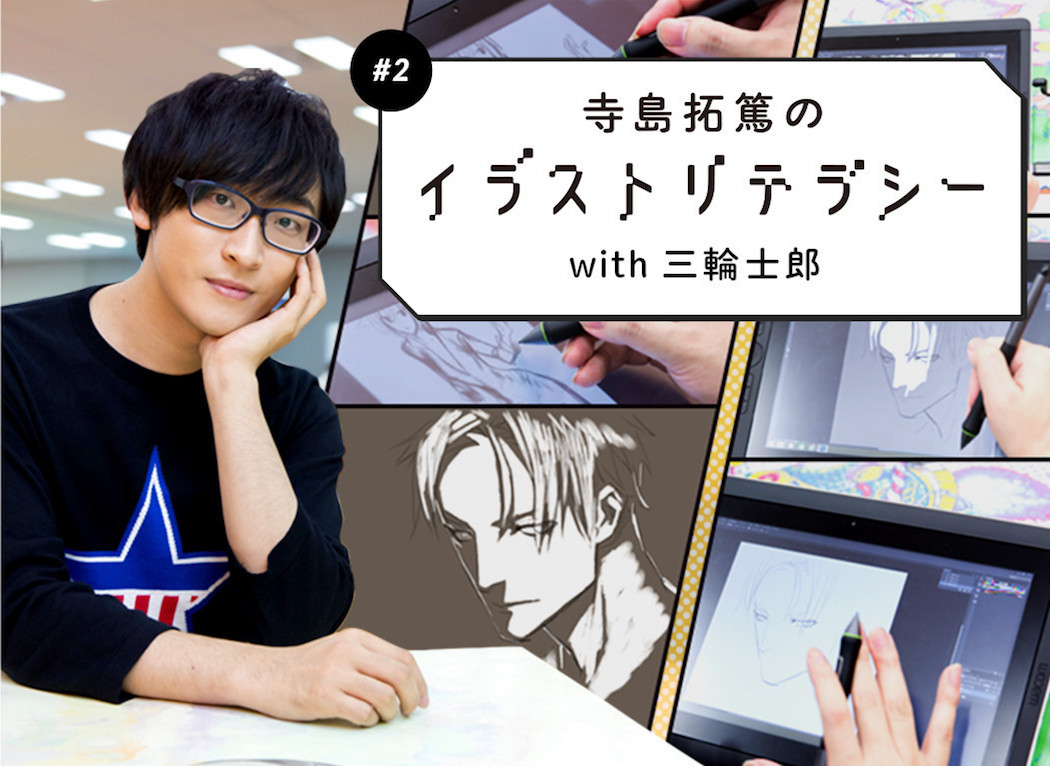
インタビュー・文:小川 陽平 撮影:山口 宏之
ペンタブレット提供:株式会社ワコム
声優の寺島拓篤さんが講師役のイラストレーターさんと共に、お絵描きの基礎やツールの使い方を学びながらカラーイラストを仕上げていく連載企画「寺島拓篤のイラストリテラシー」。前回から引き続き、漫画家・イラストレーターの三輪士郎さんを講師役にお迎えして、先日、第2回の収録が行われました。
▲こちらが、寺島さんが前回仕上げた線画イラスト。
「pixivのプロフィールアイコン用のイラストを描く」というお題は、前回までで線画が完成。執筆作業はいよいよこれから彩色へと入っていきます……とその前に、下準備として「影付け」の作業を行います。
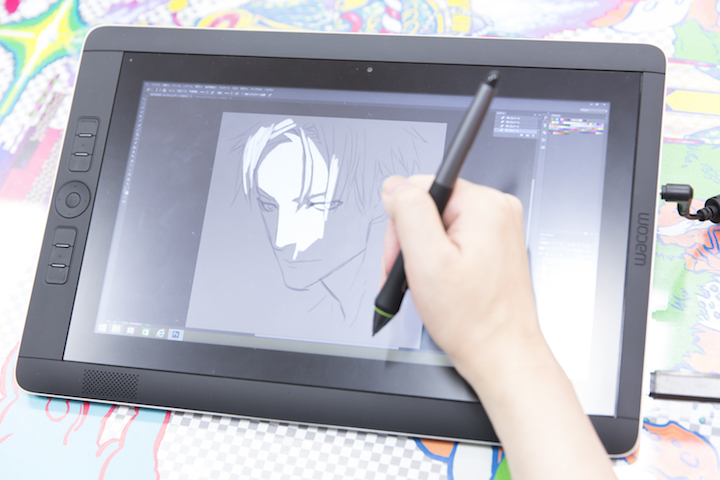
▲三輪さんによる「影付け」テクニックの実演の様子。
彩色の際に影をつけるのではなく、まず先に影だけをつけるのが三輪さん流。
こうすることで、彩色は基本ベタ塗りで作業を進められるので彩色の時間を短縮することができるうえに、早い段階で完成状態が想像できるようになり、モチベーションの維持にもつながるとのこと。
三輪さんは影付けの作業が終了したら、心情的には7割ぐらいはできあがった気持ちになるそうです。
こうすることで、彩色は基本ベタ塗りで作業を進められるので彩色の時間を短縮することができるうえに、早い段階で完成状態が想像できるようになり、モチベーションの維持にもつながるとのこと。
三輪さんは影付けの作業が終了したら、心情的には7割ぐらいはできあがった気持ちになるそうです。
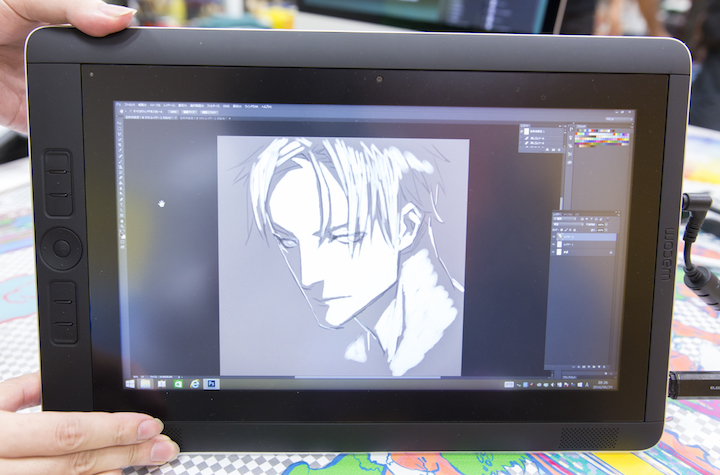
それでは、「影付け」の作業について順を追って見ていきましょう!
影付けは「Don't Think. Feel!」(考えるな、感じろ)
影になる部分を描き足すのではなく、光の当っているところを切り取っていくという、普段の執筆とは違う感覚が求められるこの作業。
三輪さんから「アニメの影の様な感じで」というアドバイスをもらい、始めは面積が広い「髪の毛」と「顔」から作業を開始します。
三輪さんから「アニメの影の様な感じで」というアドバイスをもらい、始めは面積が広い「髪の毛」と「顔」から作業を開始します。
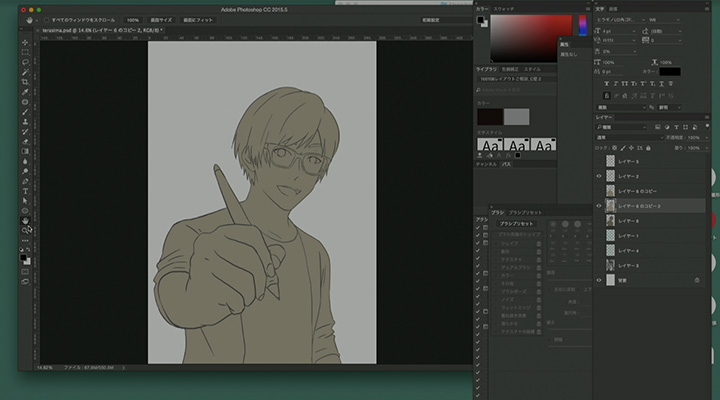
▲まずは線画の下に新たなレイヤーを作成。キャラクター全面にグレーをのせます。このグレーがキャラクターの影となります。

▲「多角形選択ツール」を選び、影を残すように光の当たるところを選択。削るというより、くりぬくという表現のほうがイメージに近いでしょうか。

「影付け作業は、ペン入れで下描きの迷い線を消すのと同じイメージ。一度感覚がつかめると、次からはもっと早くできるようになりますよ。とにかく“Don't Think. Feel!”です!」
お手本はどんどん活用しよう!
「髪の毛」→「顔」と順調に作業を進めていた寺島さんですが、前に突き出している「手」にさしかかると、少し手が止まってしまいます。複雑な形状である手を、イラストとして自然に仕上げるのは、やはり難しいようです。
そんな寺島さんへ三輪さんからのアドバイスは……。
そんな寺島さんへ三輪さんからのアドバイスは……。

「影を付ける際に一番の参考は、やっぱり実物なんですよ。今回はご自身の写真を元に描いているので、その写真を参考にしましょう。またデフォルメとリアルの境界線をどこで引くのか、常に意識することが大切ですよ」
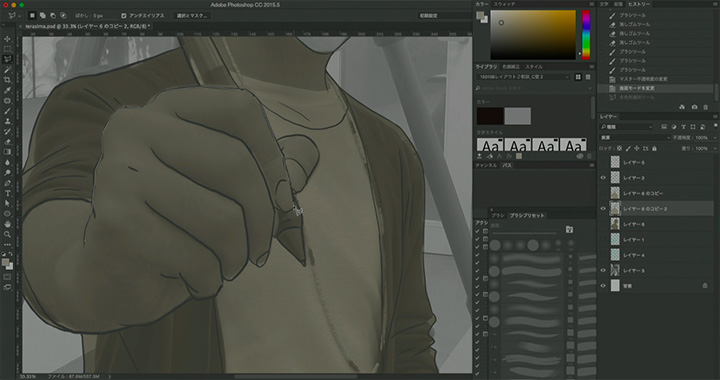
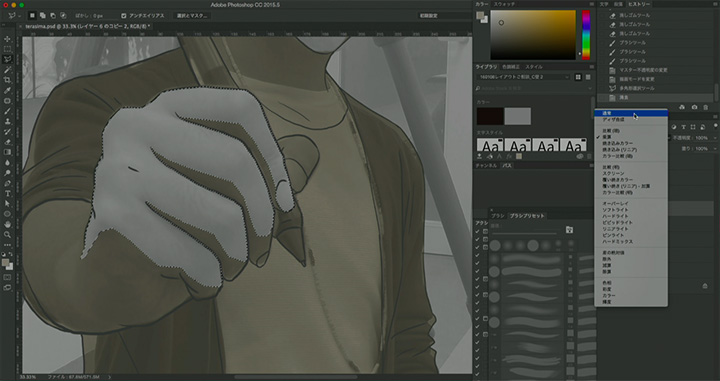
▲残していた写真のレイヤーを線画と影のレイヤーの下へ移動させ、上のレイヤーの透明度を変更して写真を見えるようにします。この時、影レイヤーの種類は“乗算”にしておくと作業しやすくなります。ただし、仕上げているのはあくまでもイラストなので、リアルな表現に寄りすぎないよう注意。
消しゴム+グラデブラシで立体感UP!
難問だった手の影付けも無事に終わり、いよいよ作業は最終段階。細かな削り残しや線の修正を終えたあと、三輪さんが「消しゴムツール」を使った完成度を高めるテクニックを教えてくれました。

「多角形選択ツールで作った影にもうひと手間を加えましょう。使うのは消しゴムツール。グラデーションブラシを選び直径を大きめに設定します。これで縁を軽く、さっとなぞるようにすると、丸みを表現できますよ」
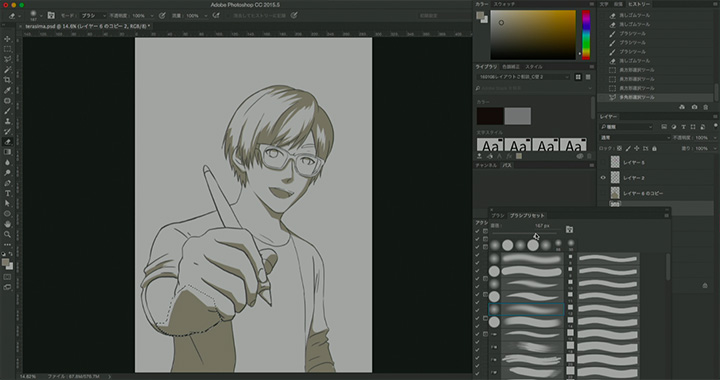
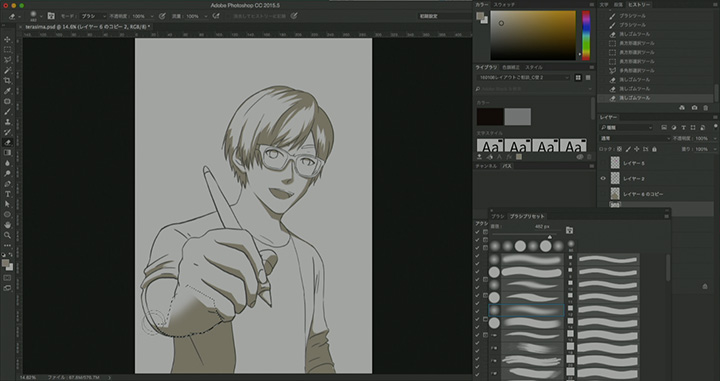
▲消しゴムツールでグラデーションブラシを選び直径を大きめに設定。多角形選択ツールで描いてあった影のふちをなぞると、より自然な影になりました。
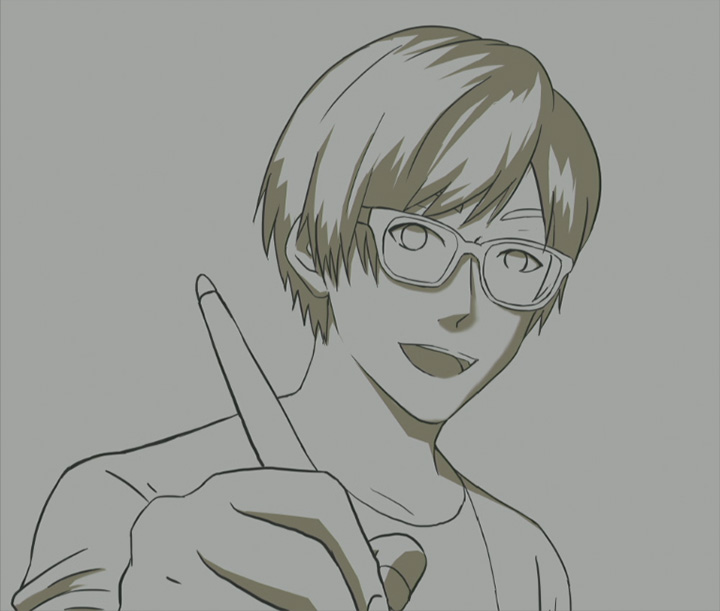

▲髪の毛も同様に消しゴムツールでさっとなぞると……天使の輪ができました!
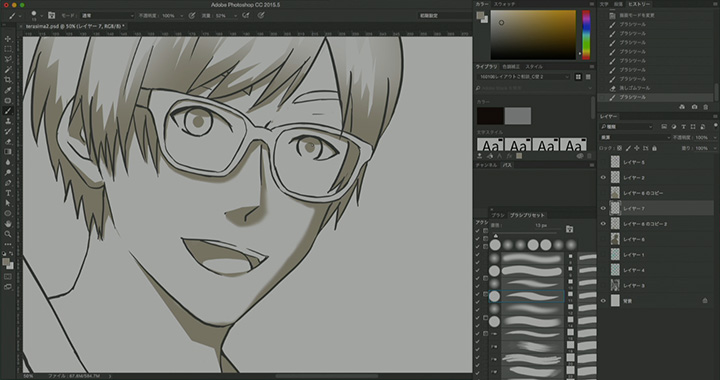
▲細かいところ、塗り残しを消しゴムツールとブラシツールで丁寧に仕上げ、最後は黒目に瞳孔を入れて影付けは完成! お疲れ様でした。
ここまでの作業は約1時間。
最初は光の当たるところをどう捉えるのかで試行錯誤していた寺島さんでしたが、徐々に感覚がつかめてきたのか後半になるにつれてスピードアップ!
その飲み込みの速さに、三輪さんも驚いている様子でした。
最初は光の当たるところをどう捉えるのかで試行錯誤していた寺島さんでしたが、徐々に感覚がつかめてきたのか後半になるにつれてスピードアップ!
その飲み込みの速さに、三輪さんも驚いている様子でした。
▲こちらが影付けをすべて終了した状態。最初の線画に立体感が加わり、完成度がグンと高まりました。
寺島さんの制作工程を動画で公開!
今回、寺島さんがチャレンジした影付けの制作工程の一部を、pixivision公式Youtubeチャンネルにて公開!
ここまでに紹介したテクニックを、ツールを使って実践していく過程を動画でも見てみてくださいね。
ここまでに紹介したテクニックを、ツールを使って実践していく過程を動画でも見てみてくださいね。
いかがでしたか?
お二人がお絵かきをする様子は、KIKI by VOICE NewTypeの本編動画にて公開されています。
三輪さんから寺島さんへのアドバイスや、真剣にお絵かきに取り組む寺島さんの奮闘の様子をぜひチェックしてみてください!
寺島拓篤のイラストリテラシー#2 - KIKI by VOICE NewType で本編動画を見る!
お二人がお絵かきをする様子は、KIKI by VOICE NewTypeの本編動画にて公開されています。
三輪さんから寺島さんへのアドバイスや、真剣にお絵かきに取り組む寺島さんの奮闘の様子をぜひチェックしてみてください!
寺島拓篤のイラストリテラシー#2 - KIKI by VOICE NewType で本編動画を見る!
三輪士郎さんに聞く!お絵かき上達への三か条!
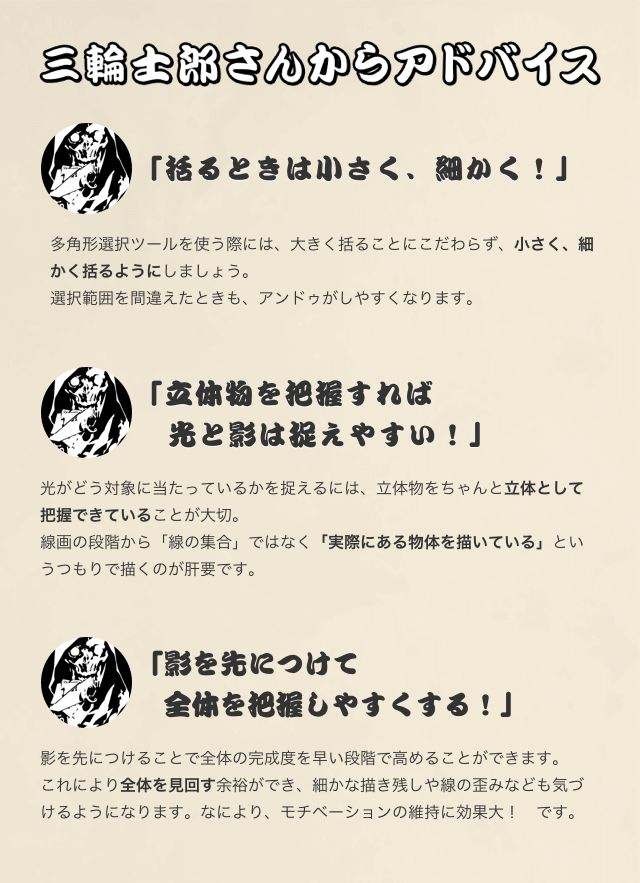
【寺島拓篤のイラストリテラシー#3】次回予告!
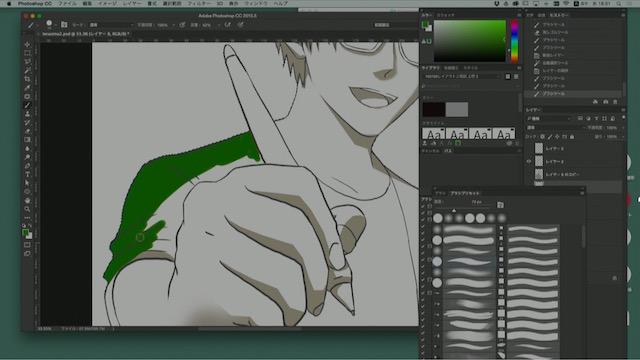
こうして影付けが終わり、着彩の準備が整いました。
次回はいよいよ色塗りに挑戦! です。
普段はモノクロで仕上げることが多いという寺島さんは、少し緊張した面持ち。ですが、今回の影付けがきちんとできていれば想像以上に簡単かつ効果的に色塗りを進められるとのこと。
どんどん変わっていくイラストに寺島さん自身が一番驚いていたその模様は、次回、第3回にてお伝えします! お楽しみに!!
次回はいよいよ色塗りに挑戦! です。
普段はモノクロで仕上げることが多いという寺島さんは、少し緊張した面持ち。ですが、今回の影付けがきちんとできていれば想像以上に簡単かつ効果的に色塗りを進められるとのこと。
どんどん変わっていくイラストに寺島さん自身が一番驚いていたその模様は、次回、第3回にてお伝えします! お楽しみに!!

今回の使用ペンタブレット

- 寺島拓篤(てらしま たくま)
- 12月20日生まれ/石川県出身/アクセルワン所属/出演作品は、「うたの☆プリンスさまっ♪」シリーズ(一十木音也)、「SUPER LOVERS」(海棠蒔麻)ほか多数。2016年8月17日(水)には6thシングル「sunlight avenue」をリリース。

- 三輪士郎(みわ しろう)
- 漫画家・イラストレーター。
1999年に『BLACK MIND』で『ウルトラジャンプ』から漫画家としてデビュー。『狗-DOGS-』を経て、現在はその続編となる『DOGS/BULLETS&CARNAGE』を連載中。
また2008年より同人音楽サークル「supercell」にイラストレーターとして参加し、メジャーデビューシングル『君の知らない物語』等のジャケットデザインを担当。2016年4月期にはTVアニメ『キズナイーバー』や『ジョーカー・ゲーム』のキャラクター原案を手がけるなど、その領域をマルチに広げ、トップクリエイターとして活躍している。






寺島さんの公式pixivアカウントをフォローして、投稿を逃さずチェック!
寺島さんが描かれたイラストが公開される「寺島拓篤公式pixivアカウント」が開設されました!この連載企画で執筆されたイラストはもちろん、寺島さんがプライベートで描かれたイラストが投稿されることも…?
ぜひフォローして作品を見てみてくださいね。
寺島さんのpixivアカウントはこちら!
また、今回の執筆の模様は動画でも公開中!
「KIKI」にて、各回の様子を随時公開していきますので、こちらも忘れずにチェック!
KIKI by VOICE Newtype